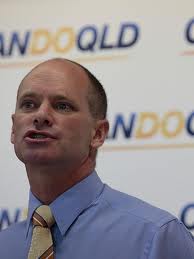Newly elected Queensland Premier Campbell Newman is expected to move quickly to disband the state’s climate change and renewable energy programs, raising questions about whether the state’s $75 million contribution to the Solar Dawn project will remain intact.
Newman has already replaced the head of Premier and Cabinet John Bradley with investment banker Jon Grayson, who cites the biggest transaction on his CV as the successful bid for the Dalrymple Coal Terminal when he was head of Prime Infrastructure.
The Department of Environment and Resource Management and the Department of Employment, Economic Development and Innovation are to be split. The office of climate change, headed by Greg Withers, the husband of ousted premier Anna Bligh, also faces an uncertain future.
According to its policy document released a day before the election, the Newman government plans to abolish eight of Labor’s environmental funds, including the solar flagships program, the $300 million climate change fund and the $50 million renewable energy fund.
The other funds identified include Queensland Smart Energy Savings Fund, the Queensland Future Growth Fund, the Solar Initiatives Package, the Waste Avoidance and Resource Efficiency Fund and Local Government Sustainable Future Fund
The document described the schemes as “redundant and a waste of taxpayer’s money in light of the federal government’s mandated Renewable Energy Target and the carbon tax.” And, therefore, any state-based scheme will simply mean Queenslanders will be paying for other states to emit more,” the document said. The carbon schemes are a “luxury Queensland just can’t afford.”
And it quoted the Productivity Commission’s submission to the Garnaut Climate Change Review, saying an “effective ETS, much of the current patchwork of climate change policies will become redundant and there will only be a residual role for state, territory and local government initiatives.” Garnaut said the same thing, but put the emphasis on the caveat word “effective”.
It is not clear whether the closure means no new spending or whether money already allocated or committed, such as the solar flagships contribution, will be repatriated. The renewable energy fund, for instance, included $9 millon for Mackay Sugar’s co-generation projet, $15 million to the University of Queensland geothermal energy’s centre of excellence, up to $4.3 million for the new geothermal power station at Birdsville. Not all of that has been spent.
The impact of withdrawing the $75 million funding from Solar Dawn is also not clear, as some of it may have been designed to support research initiatives, including a $60 million research program at the University of Queensland. Solar Dawn failed to get a power purchase agreement and financing in place in time to meet a December deadline to access $465 million in federal funding, although it won a six month extension.
A statement from the company said it “appreciated the commitment of the State of Queensland which has signed a $75 million conditional agreement with Solar Dawn for project assistance” and it looked forward to “continuing its relationship with the government” and briefing personnel on progress in the project.
The Victorian conservative government, meanwhile, has axed the 20 per cent emissions abatement target set by its Labor predecessor, despite supporting it while in Opposition.
The state government came under huge pressure to abandon the target, saying it placed an unnecessary burden on Victorian industry. Opponents included the usual industry organizations and individual companies such as Alcoa, Alinta and Exxon Mobil.
Alcoa’s submission included a boast about how it had invested heavily to reduce its emissions and improve the efficiency of its aluminium plants to gain a competitive advantage. It apparently did not see the irony in pointing out the “inefficiencies and higher costs” involved if Victoria sought a similar advantage for its economy.
The decision by the Victorian government is the latest in a series of moves which has seen it halt feed-in-tariffs, impose strict planning restrictions on wind farm developments, and announce its intention to reopen tenders for more brown coal extraction. On the plus side it has doubled the state’s energy efficiency target, and promised up to $25 million for a geothermal project need Geelong.
In NSW, meanwhile, the new coalition state government has also brought its solar tariff to an abrupt end, and is proposing similarly restrictive planning guidelines on wind farms. Queensland hasn’t needed to bother about that because there are only 12MW of wind turbines in the state in any case. (Newman has, however, vowed tor retain the state’s feed in tariff, which because it was properly structured in the first place, with a net tariff rather than a gross, has been the most successful and cost effective tariff in the country.
The message from all three Conservative governments is that climate change action and renewable energy development is a national issue and not a state one. None of the states seem interested in gaining an advantage, or attracting investment, at the expense of the other. Does this happen in any other industry?
As acting Greens leader Senator Christine Milne said today, this now increases pressure on Tony Abbott to deliver on his “bipartisan” commitment to reduce the country’s emissions by 5 per cent by 2020, without a price on carbon – a policy that looks increasingly fragile following the CSIRO’s recent dampener on the coalition’s plan to achieve its abatement through carbon farming initiatives.







